Abstract
Changes in soil properties under mechanical stress significantly influence the emergence and growth of crops, with different crops responding differently to these changes. To explore the impact of different soil compaction states on crop growth, field experiments were conducted in 2022 and 2023 in sandy loam soil in Manitoba, Canada. The crops (canola and soybean) were planted under three compaction levels created by a seeder’s press roller: no press roller (P0), one pass of the press roller (P1), and two passes of the press roller (P2). Soil mechanical properties and plant growth were measured for each treatment. The results indicated that soil shear strength increased significantly with each level of compaction from P0 to P1 and from P1 to P2, while soil surface resistance remained largely unaffected. Interestingly, soybean and canola responded differently to soil compaction. Soybeans showed no significant changes in emergence speed or final plant population across the three treatments. Conversely, canola exhibited over a 50% increase in emergence speed and more than a 100% increase in final plant population with either one (P1) or two passes (P2) of the press roller, compared to the no press roller (P0) treatment. These findings provide valuable guidance for agricultural producers and engineers in adjusting the down pressure of seeder press wheels when planting different crops.
1. Introduction
Soybean and canola are two of the world’s main oil crops and also important cash crops [1]. In addition to producing edible oil, they also have many other utilizations, including as food, fuel, and animal feed [2,3]. It is predicted that global oilseed production may reach a record harvest of 687 million tons during 2024–2025 because of a major production increase in soybean (422 million tons). There are strong indicators for a further increase in global oil crop production in the coming years [4]. To meet the soaring demand, yields of these crops on the same land area will need to increase. Under the influence of agricultural machinery operations, soil exhibits different physical characteristics. Soil compaction is one of the most common phenomena and is crucial for agricultural production. Soil compaction can affect soil properties, internal growth changes of seeds, and interactions between seeds and soil, ultimately affecting seed germination, emergence, and crop yield [5]. The soil environment is therefore crucial for the growth of crop seeds, making it important to understand the effects of soil compaction operations on soil properties.
Soil compaction is a process in which soil particles are tightly arranged due to the reduction of pore space, resulting in an increase in soil bulk density [6]. In nature, rainfall is a common factor that causes soil compaction, which usually occurs on the surface of the soil with a thickness of no more than 15cm, and can prevent the germination of seeds [7]. In agricultural production, mechanical compaction is responsible for most soil compaction [8]. From a mechanical point of view, the process of seedling emergence can be regarded as the interaction of two opposing forces: seedling emergence force and soil resistance [9]. Some studies show that when soil is compacted, an increase in soil bulk density results in a decrease in emergence rate and crop yield [10]. The reduction of soil porosity reduces hypocotyl penetration into the soil during seed emergence [11]. The low soil porosity causes hard soil and decreases soil oxygen, preventing germination and the emergence of seeds. High penetration resistance can also affect seed germination and emergence, causing a decrease in crop yield. Zhang et al. [12] studied the comparison of soil compaction by small and medium sized tractors, including the effect of tractor mass on soil compaction. Some methods have been proposed to estimate soil compaction intensity as a function of vehicle and soil properties such as the soil’s water content, bulk density, and resistance to penetration [13]. Moinfar [14] conducted a series of tests to determine the effect of the tractor driving system type on soil compaction and soil behavior. The results showed that a low tire inflation pressure (less than 250 kPa) and optimum moisture with regard to soil texture were recommended for managing soil compaction in different agricultural operations. In general, the negative effects of soil compaction include a reduction in soil porosity, limited water and air infiltration, restricted crop germination and root growth exploration, and thus reduced crop yields [15,16]. In addition, soil compaction can also cause an increase in soil aggregates, thereby affecting soil permeability [17].
However, soil compaction does have a place in agriculture. It is necessary to compact the soil at certain levels in order to increase the contact between the seed and the soil, thereby providing uniform germination [18]. Post-sowing compaction can significantly improve the emergence rate of rapeseed [19]. Proper compaction can also keep water in the soil and strengthen the seedlings. There are many factors that affect crop emergence. To determine the influencing factors of soil compaction, an efficient, standardized process was developed by Gong et al. [20] with reproducible methodology to assess seedling emergence and growth in response to increased mechanical impedance, using soybean as a model crop. In agricultural production, soil compaction is mainly carried out through compactors after seeding. Soignier [21] conducted studies to determine if planter downforce rate impacted soybean emergence and grain yield. Mechanical travel in the field is a large factor affecting the degree of soil compaction. Hakansson and Reeder [22] stated that a 14% loss on maize yield takes place after repeated wheel traffic on agricultural soils. Ferreira et al. [23] evaluated soybean yields under different soil compactions using an increasing number of passes by a tractor (0, 3, 6, and 9 passes). In addition, the diversification of planting systems also generates different pathways for soil quality [24]. In the above studies, various treatments were performed on soil properties to study the effects on crops. However, different crops are affected differently by soil compaction, depending on variables and the species studied [25], and proper compaction operations are required for different crops to increase crop yields.
In summary, a two-year field experiment was conducted in Manitoba, Canada to investigate the impact of soil compaction on the emergence of epigeal crops. The specific objectives of this experiment are to (1) investigate the effects of different compaction levels of the press roller on soil physical properties, and (2) explore the effects of different soil compaction levels on the emergence and growth of crops (canola and soybean).
2. Materials and Methods
2.1. Description of Test Equipment and Field
A four-row seeder (Plotter Choice, Kasco Manufacturing, 170W600 N, Shelbyville, IN 46176, USA) was used for the experiment. It consisted of four disc-openers, a soil cover plate, finger tines, and a press roller (Figure 1a). The opener discs had a diameter of 360 mm and a spacing of 220 mm. Behind the discs, the soil-covering plate and the finger tines covered the seeds. The press roller, composed of 17 serrated discs (diameter: 240 mm; thickness: 55 mm) arranged coaxially (Figure 1b), compressed the soil. At the same time, the press roller, driven by the ground, was connected to the fluted seed meter through a series of sprockets and chains.
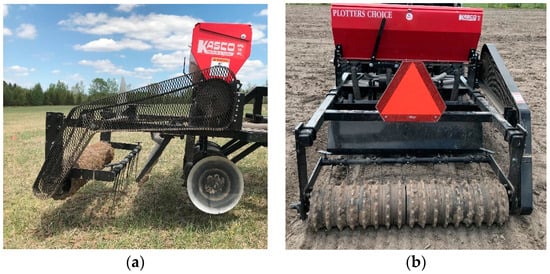
Figure 1.
Seeder. (a) Side view showing the disc openers, (b) back view showing the press roller.
The experiment was performed on a field located in the RM of Piney, Manitoba, Canada (49°07′15″ N, 96°07′56″ W). The soil comprised 73.5% sand, 23.6% silt, and 2.9% clay, and was classified as sandy loam by the USDA soil texture triangle [26]. In 2022 and 2023, the average highest temperature at this location was 22.9 °C and 23.4 °C, the lowest temperature was 11.2 °C and 10.5 °C, the relative humidity was 71% and 67%, the rainfall was 0.72 and 0.8 mm/day, and the average wind speed was 12.61 and 13.31 km/h, respectively [27]. Before seeding, the field was tilled with a disc plow, followed by a spike harrow. After tilling the soil, there were few residues from the previous crop on the soil surface.
2.2. Experimental Design and Field Layout
The experiment was conducted over two years (2022 and 2023) to examine the effects of different levels of press roller compaction on soil properties and early plant growth. The experimental design was a factorial treatment layout. The field treatments were the combinations of two crop types (Canola and soybean) and three soil pressing levels at the seeding by the press roller: no passes (P0), one pass (P1), and two passes (P2). The selection of soybean and canola seeds was based on their shared epigeal germination characteristics, where cotyledon emergence is susceptible to soil mechanical impedance during seedling establishment, coupled with their distinct size variation. Each treatment was replicated five times, giving a total of 30 plots (two crops × three pressing levels × five replicates). Each plot was 1.52 m wide to accommodate one pass of the seeder, and the plot length was 32 m. Treatments were randomly distributed in the plots as shown in Figure 2.
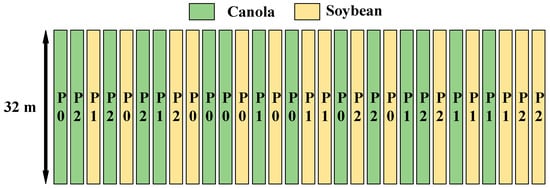
Figure 2.
The field plot layout and the random distribution of treatments; P0, P1, and P2 stand for no pressing, pressing once, and pressing twice respectively, by the press roller of the seeder.
2.3. Experimental Procedure
For the P0 treatment, the plots were seeded with the press roller being lifted above the soil surface, meaning seeding was completed without the press roller touching the soil. Thus, these seed furrows were not compacted. For the P1 treatment, the plots were seeded with the normal setup of the seeder, i.e., the press roller running on the soil surface behind the seed openers, which compacted the seed furrows. Figure 3 shows the typical soil surface condition of a P1 plot. For the P2 treatment, the plots were first seeded with the seeder being in the normal setup, then the plots were passed with the seeder again. This second time, however, the disc openers were lifted above the soil, while the press roller compressed the soil again. This means that the seed furrows in the P2 plots had two passes with the press roller. Through those operations, three different levels of soil compaction resulting from the press roller were established in the field at the time of seeding.
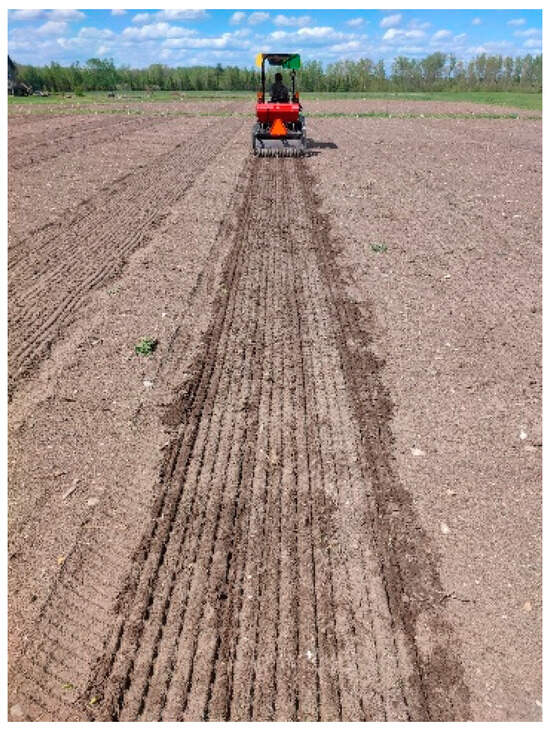
Figure 3.
Typical soil surface condition of a P1 plot (one pass of press roller).
The variety of soybean seeds used were Croplan RX000918, and that of the canola seeds were InVigor L340PC, provided by local seed suppliers in Manitoba, Canada. They were seeded in four rows per plot using 300 mm row spacing. The target seeding depth for soybean was 30 mm, recommended by Manitoba Agriculture, and that for canola was 12.5 mm, recommended by the Canola Council of Canada [28]. The travel speed of the tractor was 2.1 m·s−1 for the seeding of both crops.
2.4. Measurements
2.4.1. Initial Soil Conditions
Soil properties, including dry bulk density and soil moisture content, were measured at the time of seeding to characterize the initial soil conditions of the field. Soil samples were taken using the soil core method in seven random locations in the field prior to the seeding and compaction operations. The soil core sampler (Figure 4a) was 54 mm in diameter and 54 mm in height. Soil samples were weighed immediately after sampling. Then, they were oven-dried at 105 °C for 24 h to determine the soil moisture content (dry basis) and soil dry bulk density.

Figure 4.
Soil property measurements in field. (a) Soil core sampler; (b) Vane shear meter; (c) Penetrometer.
2.4.2. Soil Mechanical Properties
Soil mechanical properties, including soil shear strength and soil surface resistance, were measured in each plot after the seeding and compaction operations, to determine the effects of soil compaction resulting from the press roller. Soil shear strength is defined as the maximum shear stress that soil can withstand without failing, making it a crucial indicator in soil compaction. Soil shear strength was measured using a vane shear meter (Geotechnics, Auckland, New Zealand) (Figure 4b). The vane shear meter consisted of a dial, four rectangular vanes (vane height: 29 mm; vane width: 9.5 mm), and a rod. Measurements were taken by pushing the vanes into the soil until the tops of the vanes were flush with the soil surface, slowly rotating the vanes until the soil failed and reading the value on the dial. Soil surface resistance reflects the solidity of the field surface. Soil surface resistance was measured with a Humboldt dial pocket penetrometer (Figure 4c). The pocket penetrometer consisted of a 20-mm diameter (area: 314 mm2) plunger or foot and a dial with scales. The measurements were performed by pushing the plunger into the soil until its top was flush with the soil surface and recording the value shown on the dial. Measurements of soil shear strength and surface resistance were done at three random locations in each plot.
2.4.3. Plants Count
In the days following seeding, the emergence of plants was continuously monitored. At the first emergence, the emergence of seedlings in the two central rows of each plot were counted. The length of each plant row was set at one meter and marked with wooden stick (Figure 5), with counting being completed at three random locations along each plot. The final count was done when the number of plants was no longer changing. The schedule for counting the plant population in 2022 and 2023 is shown in Table 1.
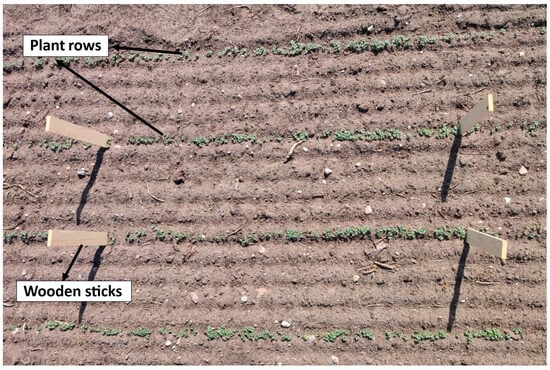
Figure 5.
Plant counting on two plant rows per plot; plant rows marked by wooden sticks.

Table 1.
Dates of counting plants for two crops.
The plant response to soil compaction by the press roller was assessed by the speed of emergence and plant population. Speed of emergence [29] was determined by the following equation:
where SE is the speed of emergence per unit row length (plants·m−1 per day), Ni is the number of newly emerged seedlings counted per day di, and L is the length of the row counted (m). The number of plants obtained as the final count was used for calculating the plant population that was defined as the number of plants per unit area.
2.5. Statistical and Data Analysis
Due to the nonhomogeneous nature of the soil and presence of small stones, the measurement data were highly variable. Therefore, before data analysis, box plots were used to filter out outliers in the data. Analysis of variance (ANOVA) was used to determine if the three compaction treatments had a significant effect on the soil properties (shear strength and surface resistance) and plant responses (speed of emergence and plant population). SPSS software (version 28.0) was used to perform the ANOVA and Duncan’s multiple range test (a pairwise comparison) at p < 0.05.
3. Results and Discussion
3.1. Initial Soil Properties
The initial average soil densities measured in 2022 and 2023 were 823.1 ± 74.6 and 830.6 ± 34.1 kg/m3, respectively. After tillage operations but before planting, the soil density was lower compared to conventional sandy loam soil, and the soil was observed to be loose during actual sampling. There were no obvious crop residues on the surface of the tilled plots, and therefore the percentage of crop residue cover was not measured. The average soil moisture content was 22.5 ± 7.8% (dry basis), which is suitable for sowing in the sandy loam soil present in the experimental field.
3.2. Soil Properties as Affected by the Compaction of the Press Roller
3.2.1. Soil Shear Strength
As shown in Table 2, the data indicated that the compaction factor had a highly significant impact on the soil shear strength (p < 0.01), crop type had no significant impact on the soil shear strength (p > 0.05), and the interaction between crop type and compaction factor had a significant impact on it. The measurement data from 2022 and 2023 showed significant differences in soil shear strength among the three different compaction treatments, both in the canola and soybean plots (Figure 6). The trends were similar, with soil shear strength increasing with a greater number of press roller passes, (53.9% for the P1 treatment and 114.3% for P2) when compared to P0. The compaction of the press roller increased the contact between soil particles, thereby increasing the bonding force between the basic particles [30]. This explains the increased soil shear strength. The type of crop planted did not make any difference in the shear strength of the soil, as expected. Slightly higher overall shear strength was observed in 2022 when compared to 2023, possibly due to the differences in soil moisture conditions between the two years.

Table 2.
Variance analysis of research indicators for different crops and soil compaction levels.
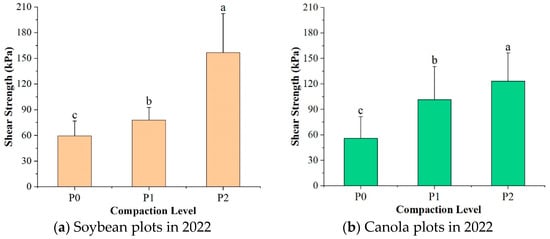
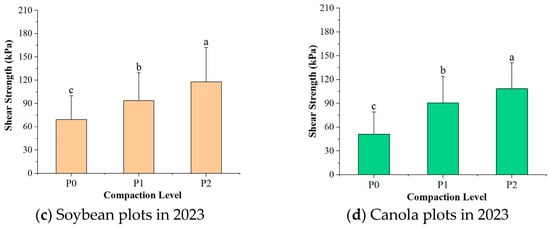
Figure 6.
Soil shear strengths for different treatment; P0, P1, and P2 stand for no pressing, pressing once, and pressing twice, respectively, by the seeder press roller; means followed by different letters are significantly different according to Duncan’s multiple range test at the significance level of 0.05; error bars are standard deviations.
3.2.2. Soil Surface Resistance
Results indicated that the compaction factor had a highly significant impact on soil resistance (p < 0.01) and crop type, and the interaction between the two factors had no significant impact on soil resistance (p > 0.05). Only the soybean field in 2022, under different compaction treatments, showed that the soil surface resistance increased significantly as the compaction level increased (Figure 7a). In the canola field in 2022, after one pass of the press roller, the soil surface resistance was not significantly changed, as indicated by the same statistical level of both P0 and P1 (Figure 7b). However, the soil surface resistance after two passes of the press roller (P2) was the highest among all the treatments. As for the results from 2023, the soybean field showed an unexpected trend (Figure 7c), whereas the canola field showed an increasing trend of soil surface resistance with the increase in compaction level (Figure 7d). Compared to the data for soil shear strength (Figure 6), the data for soil surface resistance is more irregular. This could be attributed to the shallow measurement depth when collecting the soil surface resistance data. On the topsoil layer, the seeding operation caused some soil disturbance along the seed rows, but no soil disturbance between the seed rows, creating a nonuniform soil structure. This nonuniform area was where the soil surface resistance was measured and could be the reason for the irregular soil resistance data shown in Figure 7b,c. The results are consistent with the literature study by Usowicz [31], showing that there was a large difference in the semi-variance of soil surface resistance, and its relationship with machine-induced soil compaction was not significant. In general, mixed results for soil surface resistance were obtained for the treatments P0 and P1. However, the soil with P2 always had the highest soil surface resistance, which is supported by the soil mechanical theory.

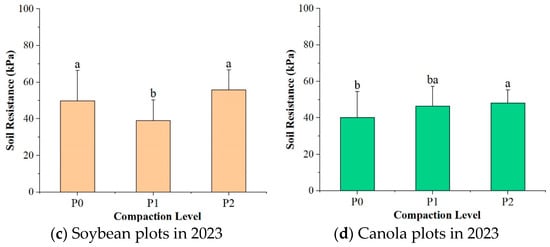
Figure 7.
Soil surface resistance of different soil compaction levels at different crop fields; P0, P1, and P2 stand for no pressing, pressing once, and pressing twice, respectively, by the seeder press roller; means followed by different letters are significantly different according to Duncan’s multiple range test at the significance level of 0.05; error bars are standard deviations.
3.3. Plants Population and Speed of Emergence
3.3.1. Speed of Emergence
As shown in Table 2, crop types and compaction level, and the interaction between the two, had a highly significant impact on the speed of emergence (p < 0.01). In 2022, the canola and soybeans seeds took 7 days and 6 days, respectively, to emerge, while in 2023, both canola and soybeans took the same 5 days to emerge. These are typical for the given conditions of temperature and soil moisture. There were no significant differences in the speed of soybean emergence in 2022 (Figure 8a). Plant emergence remained relatively constant around eight plants·m−1/day for all compaction treatments. However, the speed of canola emergence was significantly lower in the P0 treatment than in the P1 and P2 treatments (Figure 8b). The one pass of the press roller (P1) significantly increased the speed of canola emergence by 57.9%. However, further compaction (P2) of the soil did not significantly affect the speed of emergence. Furthermore, the compaction effect trend in 2022 was confirmed by the data in 2023 (Figure 8c,d). Results indicated that soil compaction by the press roller did not have a negative impact on the speed of canola emergence. In contrast, compaction promoted a fast speed of emergence. This could possibly be due to the better soil–seed contact resulting from the compression action of the press roller. Another possible explanation is the fact that compacted soil preserves soil moisture content by reducing evaporation. The higher soil moisture content favors fast germination and cotyledon growth, reflected by the fast speed of emergence. The results showed that soybeans were less sensitive to soil compaction when compared to canola. This was in line with the findings in the literature. Excessive soil compaction can lead to degradation of the physical, chemical, and biological properties of sol, which negatively impacts crop growth and consequently reduces agricultural yields [32]. However, soil compaction at different intensities can be a favorable or unfavorable factor for the emergence of specific crop seeds [30]. This also reflected the sensitivity of smaller canola seeds to soil compaction [33].
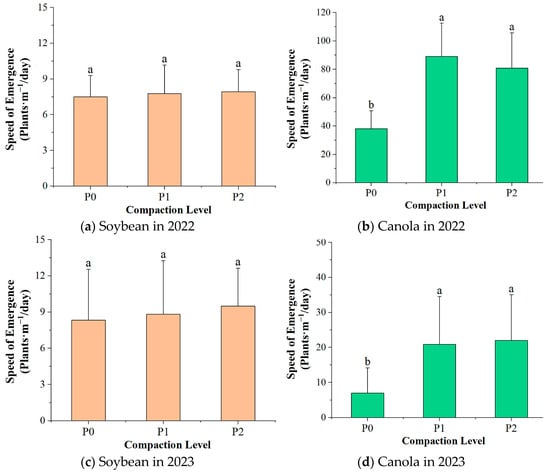
Figure 8.
Speed of plant emergence in 2022 and 2023; P0, P1, and P2 stand for no pressing, pressing once, and pressing twice, respectively, by the seeder press roller; means followed by different letters are significantly different according to Duncan’s multiple range test at the significance level of 0.05; error bars are standard deviations.
3.3.2. Plant Population
Both crop types and compaction level, and the interaction between the two, had a highly significant impact on the plant population (p < 0.01) (Table 2). Examples of the field conditions with emerged plants are shown in Figure 9. It should be noted that in 2022, the plant sowing density for the small canola seeds was affected due to difficulties in adjusting the seed meter of the seeder. However, this would not significantly impact the data at the emergence stage when plants are small. Figure 9c showed healthy crop growth status in the middle of the growing season. The initial intention was to measure crop yields. However, in both years, the field was destroyed by deer before the crops matured. As a result, the final yield data were not able to be obtained. Future studies on yields are recommended.
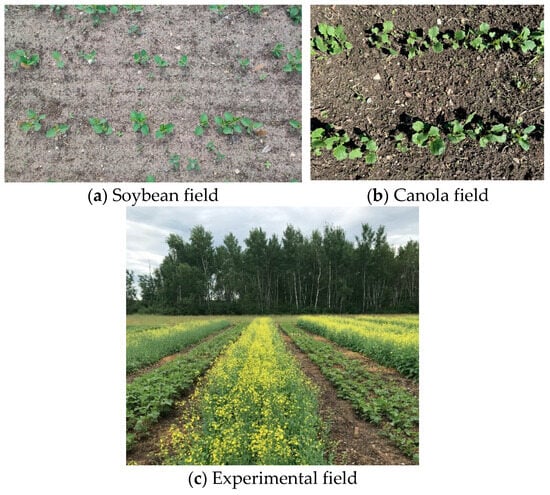
Figure 9.
The growth status of canola and soybean crops in spring and in the middle of the growing season.
After the number of plant counts remained constant, the final plant count was taken as the final population of the crop. In the 2022 survey, the soybean plant counts for P0, P1, and P2 were 7.76, 8.43, and 8.76, respectively, while the canola plant counts were 65.93, 122.76, and 103.73. In the 2023 survey, the soybean plant numbers for P0, P1, and P2 were 8.80, 8.46, and 9.80, respectively, and the canola plant counts were 10.00, 26.6, and 25.73. Figure 10 shows the plant populations of the two crops over two years. The results showed a slight, non-significant increase for the soybean plant population in 2022 with an increase in the number of soil compactions (Figure 10a). Literature studies showed that higher soil compaction negatively affects soybean plant emergence [34]. These existing studies dealt with compaction from heavier machinery, such as tractors, seeders, sprayers, harvesters, and grain chasers [35]. In this study, the compaction was induced by the pass of the press roller of the seeder, which was not sufficient to affect soybean plants. In a study by Gong et al. [20] analyzing the limit of germination force for soybean seeds, similar conclusions were drawn: soybeans can germinate and expand in soils with higher compaction and remain unaffected. In similar simulation studies, soybeans can also adjust the emergence angle of cotyledons to minimize soil resistance during emergence [36]. However, small-sized canola seeds lack this ability. Previous agronomic studies have also shown that soybean seedling emergence ability was significantly affected by seed size [37] and orientation [38]. The difference in seed morphology and orientation during the emergence process may be the reason for the differences in results under different compacted soils in this study. In Ferreira’s study [23], higher tractor pass frequencies (three, six, and nine passes) were applied, which significantly increased soil compaction levels and resulted in a 12–19% yield reduction in soybean crops. Based on the measurements of soil mechanical properties in this study, it is unlikely to cause any adverse effects to the soybean crop if the soil shear strength is lower than 156.8 kPa, or soil surface resistance is lower than 74.6 kPa, which was the P2 treatment in this experiment.
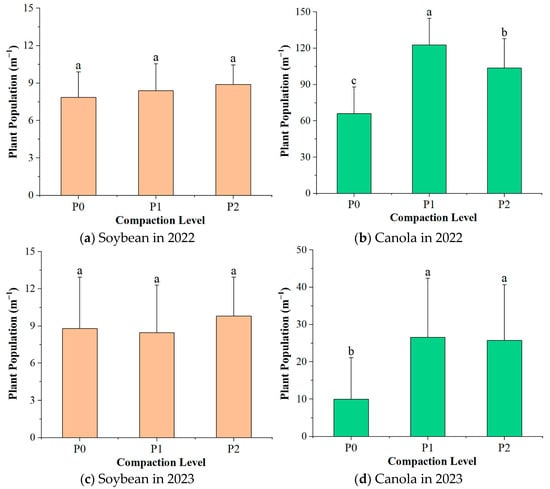
Figure 10.
Plant population of soybean and canola in 2022 and 2023; P0, P1, and P2 stand for no pressing, pressing once, and pressing twice, respectively, by the seeder press roller; means followed by different letters are significantly different according to Duncan’s multiple range test at the significance level of 0.05; error bars are standard deviations.
The lowest plant population was observed in the P0 treatment plots, while one pass of the press roller (P1) led to a significant rise in plant population, with an average increase of 126.1%. This agreed with the findings of Tong et al. [39], where they used three weights (300 N, 500 N, and 700 N) of compaction rollers for maize sowing and observed that the roller with a weight of 700 N achieved the highest maize seed emergence rate. However, as mentioned above, canola seeds are small, and the results showed that they were sensitive to soil compaction. The range of soil compaction that promoted the emergence of small seeds was very narrow. However, during the germination and growth process of soybean seeds, significant changes in size are caused by water absorption and expanding [40]. Therefore, the emergence was inhibited in P2 treatment. Compared to the plant population in the P0 treatment, the plant population in the P2 treatment decreased by 15.5% in 2022, while in 2023, the effects of compaction on the plant population were similar to those in 2022, i.e., soybean had similar plant density, regardless of the number of press roller passes (Figure 10c), and fewer canola plants were in the P0 plots (Figure 10d). In 2022 and 2023, the plant population of canola in the P2 treatment decreased by an average of 9.4%
Similar to this study, Zuo et al. [41] observed an increase in emergence rate after compacting canola seeds sown at a depth of 20 mm, compared to a non-compacted treatment. In Zheng’s research [42], it has also been shown that the adhesion and particle composition between soil particles have a significant impact on seed germination and seedling growth. In the above studies, the observed emergence of canola under different levels of soil compaction reflected that within a certain range, soil compaction promoted canola emergence, but the range in which it promoted emergence was relatively small. The impact of soil compaction on canola crops may vary significantly compared to other crops, regardless of the compaction source. According to Shah et al. [43], tractor wheel traffic-induced soil compaction can reduce canola biomass by up to 62%, highlighting the crop’s heightened sensitivity to such conditions. In this study, further secondary compaction (P2 treatment) had a suppressing effect on emergence, indicating that the effective range of soil compaction in promoting the canola seed emergence rate is near the soil property of P1 treatment, with a soil shear strength of around 96.0 kPa and soil surface resistance of 52.6 kPa under the given soil and soil conditions.
4. Conclusions
A field experiment was conducted to investigate the mechanical properties of soil and the growth of soybean and canola under varying levels of soil compaction created by a seeder’s press roller. The results showed that soil shear strength was more responsive to compaction than soil surface resistance. As the number of press roller passes increased, the soil shear strength demonstrated significant enhancement, rising from 51.38 to 156.38 kPa, while the surface resistance showed minimal variation. This suggests that soil shear strength is a more reliable indicator for assessing the effects of seeder press wheels on soil mechanical properties, as soil surface resistance measurements are limited by their shallow depth. Soybean emergence speed and final plant population were not significantly affected by the press roller. In contrast, canola showed improved emergence and plant population when the press roller passed once or twice during seeding, with an average increase of 126.1%. These results suggest that moderate soil compaction can enhance soil–seed contact and preserve soil moisture, benefiting plant emergence. Furthermore, as large epigeal seeds, soybeans encounter greater soil resistance during emergence due to the movement of their sizable cotyledons through the soil. Nevertheless, they possess a greater capacity to overcome this resistance. Small seeds like canola were more sensitive to soil compaction compared to larger seeds like soybean, which were not significantly affected by the compaction levels used in this study. This study demonstrates that soil compaction caused by seeder press wheels affects the early growth of different crops in distinct ways, underscoring the importance of adjusting seeding equipment based on crop type to optimize conditions for crop establishment. Specifically, this study reveals how soil compaction influences the emergence rates and early growth characteristics of soybean and canola—such as emergence speed and morphological development—highlighting its potential implications for food security. By proposing optimized farming practices such as managing mechanical compaction levels and improving soil structure, the findings offer scientific support for enhancing crop production efficiency. These insights contribute to the achievement of the Zero Hunger target under the United Nations’ 17th Sustainable Development Goal (SDG), and promote sustainable agricultural practices. However, the study was limited to a single soil type, and crop yields were not measured due to natural reasons. Further research is needed to verify these results across different soil types and conditions.
Author Contributions
Methodology, H.G., Z.T., Y.C. (Yinghu Cai), Y.C. (Ying Chen) and L.Q.; software, Y.Z. and S.Y.; validation, Y.C. (Yinghu Cai), Y.Z., S.Y., Y.C. (Ying Chen) and L.Q.; writing—original draft preparation, H.G. and Z.T.; writing—review and editing, H.G., Z.T. and Y.C. (Ying Chen); supervision, L.Q.; funding acquisition, L.Q., H.G. and Z.T. have made the same contribution to the paper, and they are co first authors, with H.G. ranking first and Z.T. ranking second. All authors have read and agreed to the published version of the manuscript.
Funding
The research was funded by the Natural Science Foundation of China, grant number 32171904; the National Key Research and Development Plan of China, grant number 2023YFD1701004; the Earmarked Fund for Modern Agro-industry Technology Research System in China, grant number CARS-01; the Disciplinary Development Project of Guangdong Province for Key Technologies Research and Integrated Application in Smart Agriculture, grant number 2023B10564002.
Data Availability Statement
The data has been presented in the article.
Conflicts of Interest
The authors declare no conflicts of interest.
References
- OECD/FAO. OECD-FAO Agricultural Outlook 2015; OECD Publishing: Paris, France, 2015. [Google Scholar]
- Mcansh, J. Place of rapeseed in the edible oil market. J. Am. Oil Chem. Soc. 1973, 50, 404–406. [Google Scholar] [CrossRef] [PubMed]
- Wanasundara, J.P.; McIntosh, T.C.; Perera, S.P.; Withana-Gamage, T.S.; Mitra, P. Canola/rapeseed protein-functionality and nutrition. OCL 2016, 23, D407. [Google Scholar] [CrossRef]
- Pandey, M.K.; Mallikarjuna, M.G.; Lohithaswa, H.C.; Aski, M.S.; Gupta, S. Introduction: Breeding Climate-Resilient and Future Ready Oilseed Crops. In Breeding Climate Resilient and Future Ready Oilseed Crops; Springer Nature Singapore: Singapore, 2025; pp. 1–6. [Google Scholar]
- Nelson, E.B. The seed microbiome: Origins, interactions, and impacts. Plant Soil 2018, 422, 7–34. [Google Scholar] [CrossRef]
- Soil Science Society of America. Glossary of Soil Science Terms 2008; Soil Science: Madison, WI, USA, 2008. [Google Scholar]
- DeJong-Hughes, J.; Moncrief, J.F.; Voorhees, W.B.; Swan, J.B. Soil Compaction: Causes, Effects and Control; University of Minnesota Extension Service: St. Paul, MN, USA, 2001. [Google Scholar]
- Hou, S.; Wei, Z.; Shi, N.; Ji, W.; Zou, Z. Design and parameter optimizing test of elastic spiral soil covering roller. J. Agric. Mech. Res. 2021, 43, 42–51. [Google Scholar]
- Steinbrecher, T.; Leubner-Metzger, G. The biomechanics of seed germination. J. Exp. Bot. 2017, 68, 765–783. [Google Scholar] [CrossRef]
- Botta, G.F.; Becerra, A.T.; Melcon, F.B. Seedbed compaction produced by traffic on four tillage regimes in the rolling Pampas of Argentina. Soil Tillage Res. 2009, 105, 128–134. [Google Scholar] [CrossRef]
- Botta, G.F.; Pozzolo, O.; Bomben, M.; Rosatto, H.; Rivero, D.; Ressia, M.; Tourn, M.; Soza, E.; Vazquez, J. Traffic alternatives for harvesting soybean (Glycine max L.): Effect on yields and soil under a direct sowing system. Soil Tillage Res. 2007, 96, 145–154. [Google Scholar] [CrossRef]
- Zhang, X.Y.; Cruse, R.M.; Sui, Y.Y.; Jhao, Z. Soil compaction induced by small tractor traffic in Northeast China. Soil Sci. Soc. Am. J. 2006, 70, 613–619. [Google Scholar] [CrossRef]
- Elaoud, A.; Chehaibi, S. Soil compaction due to tractor traffic. J. Fail. Anal. Prev. 2011, 11, 539–545. [Google Scholar] [CrossRef]
- Moinfar, A.; Shahgholi, G.; Abbaspour-Gilandeh, Y.; Herrera-Miranda, I.; Hernández-Hernández, J.L.; Herrera-Miranda, M.A. Investigating the effect of the tractor drive system type on soil behavior under tractor tires. Agronomy 2021, 11, 696. [Google Scholar] [CrossRef]
- Bassett, I.E.; Simcock, R.C.; Mitchell, N.D. Consequences of soil compaction for seedling establishment: Implications for natural regeneration and restoration. Austral Ecol. 2005, 30, 827–833. [Google Scholar] [CrossRef]
- Sidhu, D.; Duiker, W. Soil compaction in conservation tillage: Crops impacts. Agron. J. 2006, 98, 1257–1264. [Google Scholar] [CrossRef]
- Kenjaev, Y.; Aripov, R. The agrophysical properties effects in syderation used short-row sowing on soil. In E3S Web of Conferences; EDP Sciences: Les Ulis, France, 2024; Volume 497, p. 03002. [Google Scholar]
- Kucukerdem, H.K.; Altikat, S. Evaluating Effects of Post-Sowing Compaction and Sowing Speed on Soil Properties, Distribution of Seed Placement and Second Crop Maize Performance. Agric. Mech. ASIA Afr. Lat. Am. 2022, 53, 46. [Google Scholar]
- Botta, G.F.; Tolón-Becerra, A.; Lastra-Bravo, X.; Tourn, M.; Balbuena, R.; Rivero, D. Continuous application of direct sowing: Traffic effect on subsoil compaction and maize (Zea mays L.) yields in Argentinean Pampas. Soil Tillage Res. 2013, 134, 111–120. [Google Scholar] [CrossRef]
- Gong, H.; Chen, Y.; Zheng, W.; Zeng, Z.; Li, S.; Qi, L. Measurements and DEM modelling of soybean seed expansion. Comput. Electron. Agric. 2023, 208, 107786. [Google Scholar] [CrossRef]
- Soignier, T.S.; Plumblee, M.T.; Mueller, J.D.; Greene, J.K.; Kirk, K.R. The evaluation of planter downforce on emergence and grain yield in soybean. Crop. Forage Turfgrass Manag. 2022, 8, e20186. [Google Scholar] [CrossRef]
- Hakansson, I.; Reeder, R.C. Subsoil compaction by vehicles with high axle load—Extent, persistence and crop response. Soil Tillage Res. 1994, 29, 277–304. [Google Scholar] [CrossRef]
- Ferreira, C.J.B.; Tormena, C.A.; Severiano, E.D.C.; Zotarelli, L.; Betioli Júnior, E. Soil compaction influences soil physical quality and soybean yield under long-term no-tillage. Arch. Agron. Soil Sci. 2021, 67, 383–396. [Google Scholar] [CrossRef]
- Alvarez, S.; Ernst, O. Impact of cropping systems on soil quality. Eur. J. Agron. 2024, 158, 127197. [Google Scholar] [CrossRef]
- Alameda, D.; Villar, R. Moderate soil compaction: Implications on growth and architecture in seedlings of 17 woody plant species. Soil Tillage Res. 2009, 103, 325–331. [Google Scholar] [CrossRef]
- Acquah, K.; Chen, Y. Soil compaction from wheel traffic under three tillage systems. Agriculture 2022, 12, 219. [Google Scholar] [CrossRef]
- Owusu-Sekyere, E.; Chen, Y. The Effect of Varying Compaction Levels on Soil Dynamic Properties and the Growth of Canola (Brassica napus L.). Agriculture 2024, 14, 1976. [Google Scholar] [CrossRef]
- CCC. The Canola Council of Canada. Plant Establishment—Seed Depth. Available online: https://www.canolacouncil.org/canola-encyclopedia/plant-establishment/seed-depth/ (accessed on 8 September 2021).
- Tessier, S.; Saxton, K.E.; Papendick, R.I.; Hyde, G.M. Zero-tillage furrow opener effects on seed environment and wheat emergence. Soil Tillage Res. 1991, 21, 347–360. [Google Scholar] [CrossRef]
- Guerif, J. Effects of compaction on soil strength parameters. Dev. Agric. Eng. 1994, 11, 191–214. [Google Scholar]
- Usowicz, B.; Lipiec, J. Spatial distribution of soil penetration resistance as affected by soil compaction: The fractal approach. Ecol. Complex. 2009, 6, 263–271. [Google Scholar] [CrossRef]
- Long, Z.J.; Wang, Y.F.; Sun, B.R.; Tang, X.Y.; Jin, K.M. Impact of mechanical compaction on crop growth and sustainable agriculture. Front. Agric. Sci. Eng. 2024, 11, 243. [Google Scholar]
- Swanepoel, P.A.; Le Roux, P.J.G.; Agenbag, G.A.; Strauss, J.A.; MacLaren, C. Seed-drill opener type and crop residue load affect canola establishment, but only residue load affects yield. Agron. J. 2019, 111, 1658–1665. [Google Scholar] [CrossRef]
- Sivarajan, S.; Maharlooei, M.; Bajwa, S.G.; Nowatzki, J. Impact of soil compaction due to wheel traffic on corn and soybean growth, development and yield. Soil Tillage Res. 2018, 175, 234–243. [Google Scholar] [CrossRef]
- Botta, G.F.; Nardon, G.F.; Guirado Clavijo, R. Soil sustainability: Analysis of the soil compaction under heavy agricultural machinery traffic in extensive crops. Agronomy 2022, 12, 282. [Google Scholar] [CrossRef]
- Zeng, Z.; Chen, Y.; Qi, L. Simulation of cotyledon-soil dynamics using the discrete element method (DEM). Comput. Electron. Agric. 2020, 174, 105505. [Google Scholar] [CrossRef]
- Kering, M.K.; Zhang, B. Effect of priming and seed size on germination and emergence of six food-type soybean varieties. Int. J. Agron. 2015, 2015, 859212. [Google Scholar] [CrossRef]
- Bowers, S.A.; Hayden, C.W. Influence of Seed Orientation on Bean Seedling Emergence 1. Agron. J. 1972, 64, 736–738. [Google Scholar] [CrossRef]
- Tong, J.; Zhang, Q.; Guo, L.; Chang, Y.; Guo, Y.; Zhu, F.; Chen, D.; Liu, X. Compaction performance of biomimetic press roller to soil. J. Bionic Eng. 2015, 12, 152–159. [Google Scholar] [CrossRef]
- Doria, E.; Pagano, A.; Ferreri, C.; Larocca, A.V.; Macovei, A.; Araújo, S.D.S.; Balestrazzi, A. How does the seed pre-germinative metabolism fight against imbibition damage? Emerging roles of fatty acid cohort and antioxidant defence. Front. Plant Sci. 2019, 10, 1505. [Google Scholar] [CrossRef]
- Zuo, Q.; Kuai, J.; Zhao, L.; Hu, Z.; Wu, J.; Zhou, G. The effect of sowing depth and soil compaction on the growth and yield of rapeseed in rice straw returning field. Field Crops Res. 2017, 203, 47–54. [Google Scholar] [CrossRef]
- Zheng, H.X.; Huang, X.; Cai., L.P.; Hou., X.L.; Zhou., C.F.; Zeng., Y.S.; Wei., M.Y.; Qiu., Q.S. Effects of soil particle composition and adhesives on seed germination and seedling growth of Neyraudia reynaudiana. Acta Prataculturae Sin. 2020, 29, 92–102. [Google Scholar]
- Shah, A.N.; Tanveer, M.; Shahzad, B.; Yang, G.; Fahad, S.; Ali, S.; Bukhari, M.A.; Tung, S.A.; Hafeez, A.; Souliyanonh, B. Soil compaction effects on soil health and crop productivity: An overview. Environ. Sci. Pollut. Res. 2017, 24, 10056–10067. [Google Scholar] [CrossRef]
Disclaimer/Publisher’s Note: The statements, opinions and data contained in all publications are solely those of the individual author(s) and contributor(s) and not of MDPI and/or the editor(s). MDPI and/or the editor(s) disclaim responsibility for any injury to people or property resulting from any ideas, methods, instructions or products referred to in the content. |
© 2025 by the authors. Licensee MDPI, Basel, Switzerland. This article is an open access article distributed under the terms and conditions of the Creative Commons Attribution (CC BY) license (https://creativecommons.org/licenses/by/4.0/).